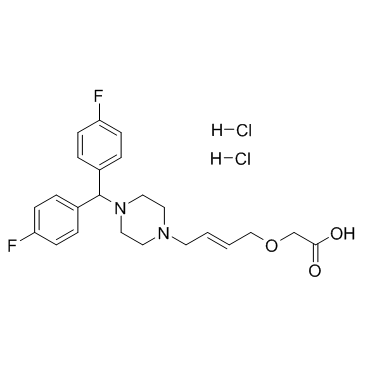607736-84-5
| Name | SUN 1334H |
|---|---|
| Synonyms |
{[(2E)-4-{4-[Bis(4-fluorophenyl)methyl]-1-piperazinyl}-2-buten-1-yl]oxy}acetic acid dihydrochloride
Acetic acid, 2-[[(2E)-4-[4-[bis(4-fluorophenyl)methyl]-1-piperazinyl]-2-buten-1-yl]oxy]-, hydrochloride (1:2) |
| Description | SUN 1334H is a potent, orally active, highly selective H1 receptor antagonist, with Ki of 9.7 nM. |
|---|---|
| Related Catalog | |
| Target |
Ki: 9.7 nM (H1 receptor)[1] |
| In Vitro | SUN-1334H causes potent inhibition of histamine induced contractions of isolated guinea-pig ileum with an IC50 (half the maximal inhibitory concentration) of 0.198 μM. In CHO-K1/hERG cells, SUN-1334H does not modulate hERG K+-currents at concentrations as high as 100 μM[1]. SUN-1334H, cetirizine and hydroxyzine cause comparable inhibition of NLF leukocytes, IL-4 and total protein concentrations[2]. |
| In Vivo | SUN-1334H potently inhibits histamine-induced bronchospasm over 24 hours following oral administration and completely suppresses histamine-induced skin wheal in beagle dogs and ovalbumin-induced rhinitis in guinea pigs[1]. In skin allergy models, SUN-1334H shows potent reduction of passive and active cutaneous anaphylactic reactions. In central nervous system side effects models, SUN-1334H, desloratadine and fexofenadine are devoid of any significant effects[2]. |
| References |
| Molecular Formula | C23H28Cl2F2N2O3 |
|---|---|
| Molecular Weight | 489.383 |
| Exact Mass | 488.144501 |
| Storage condition | 2-8℃ |
